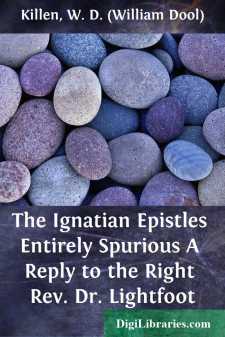Categories
- Antiques & Collectibles 13
- Architecture 36
- Art 48
- Bibles 22
- Biography & Autobiography 813
- Body, Mind & Spirit 142
- Business & Economics 28
- Children's Books 15
- Children's Fiction 12
- Computers 4
- Cooking 94
- Crafts & Hobbies 4
- Drama 346
- Education 46
- Family & Relationships 57
- Fiction 11828
- Games 19
- Gardening 17
- Health & Fitness 34
- History 1377
- House & Home 1
- Humor 147
- Juvenile Fiction 1873
- Juvenile Nonfiction 202
- Language Arts & Disciplines 88
- Law 16
- Literary Collections 686
- Literary Criticism 179
- Mathematics 13
- Medical 41
- Music 40
- Nature 179
- Non-Classifiable 1768
- Performing Arts 7
- Periodicals 1453
- Philosophy 64
- Photography 2
- Poetry 896
- Political Science 203
- Psychology 42
- Reference 154
- Religion 513
- Science 126
- Self-Help 84
- Social Science 81
- Sports & Recreation 34
- Study Aids 3
- Technology & Engineering 59
- Transportation 23
- Travel 463
- True Crime 29
The Ignatian Epistles Entirely Spurious A Reply to the Right Rev. Dr. Lightfoot
Description:
Excerpt
CHAPTER I.
PRELIMINARY OBSERVATIONS.
The question of the genuineness of the Epistles attributed to Ignatius of Antioch has continued to awaken interest ever since the period of the Reformation. That great religious revolution gave an immense impetus to the critical spirit; and when brought under the light of its examination, not a few documents, the claims of which had long passed unchallenged, were summarily pronounced spurious. Eusebius, writing in the fourth century, names only seven letters as attributed to Ignatius; but long before the days of Luther, more than double that number were in circulation. Many of these were speedily condemned by the critics of the sixteenth century. Even the seven recognised by Eusebius were regarded with grave suspicion; and Calvin—who then stood at the head of Protestant theologians—did not hesitate to denounce the whole of them as forgeries. The work, long employed as a text-book in Cambridge and Oxford, was the Institutes of the Reformer of Geneva; [Endnote 2:1] and as his views on this subject are there proclaimed very emphatically, [2:2] we may presume that the entire body of the Ignatian literature was at that time viewed with distrust by the leaders of thought in the English universities. But when the doctrine of the Divine Right of Episcopacy began to be promulgated, the seven letters rose in the estimation of the advocates of the hierarchy; and an extreme desire was manifested to establish their pretensions. So great was the importance attached to their evidence, that in 1644—in the very midst of the din and confusion of the civil war between Charles I. and his Parliament—the pious and erudite Archbishop Ussher presented the literary world with a new edition of these memorials. Two years later the renowned Isaac Vossius produced a kindred publication. Some time afterwards, Daillé, a learned French Protestant minister, attacked them with great ability; and proved, to the satisfaction of many readers, that they are utterly unworthy of credit. Pearson, subsequently Bishop of Chester, now entered the arena, and in a work of much talent and research—the fruit of six years' labour—attempted to restore their reputation. This vindication was not permitted to pass without an answer; but, meanwhile, the dark prospects of the Reformed faith in England and the Continent directed attention to matters of more absorbing interest, and the controversy was discontinued. From time to time, however, these Epistles were kept before the eyes of the public by Archbishop Wake and other editors; and more recently the appearance of a Syriac copy of three of them—printed under the supervision of the late Rev. Dr. Cureton—reopened the discussion. Dr. Cureton maintained that his three Epistles are the only genuine remains of the pastor of Antioch. In a still later publication, [3:1] Bishop Lightfoot controverts the views of Dr. Cureton, and makes a vigorous effort to uphold the credit of the seven letters quoted by Eusebius and supported by Pearson....



